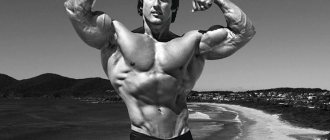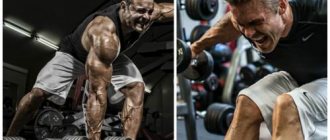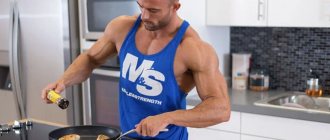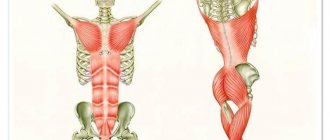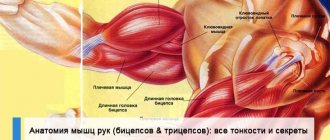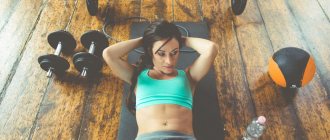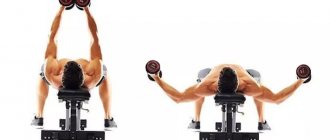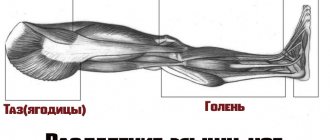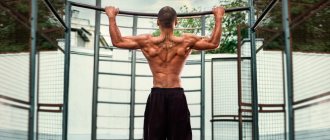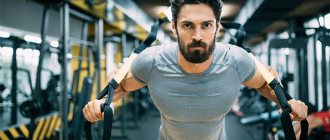Pumping in bodybuilding at certain stages of athletes’ training is a necessary method of improving the quality and definition of muscles while maintaining impressive volumes. The effect obtained from pumping visually increases muscle volume, but does not radically affect muscle hypertrophy, that is, an increase in muscle mass. This “tricky move” really helps to get voluminous muscles, but the effect is temporary.
How to achieve pumping
This technique only works if muscle volumes have already reached a certain size. For example, in relaxed and untrained muscles, the pumping effect will not be as noticeable, that is, the shape of the muscles will not gain relief. On the one hand, this regime allows you to strengthen unprepared muscles and ligaments to further increase muscle mass, but the pumping effect itself is necessary at the moment when the athlete “dries” the muscles and prepares for posing in competitions.
Training should be carried out at least 3-4 times a week. The program should be designed for one or two muscle groups in one workout. Optimal number of repetitions: 15-20 times per approach. Also, the maximum effect will be achieved by performing supersets and trisets, respectively, 2-3 exercises per group without rest.
Pumping will also allow iron lovers to gain distinct shapes and visually “pump up” them, but due to blood flow. In this case, the method will help prepare for the beach season. But this effect lasts as long as the training is done regularly and the diet remains balanced, not excluding carbohydrates. During long periods of rest, it is impossible to maintain a constant flow of blood, so the muscles seem to “deflate.”
Achieving a pump on a no-carb diet is difficult. It is carbohydrates that contribute to the “flooding” of muscles, and amino acids alone, necessary for pumping, will not cope with the task. Thanks to repeated repetitions, muscles expend energy, emptying carbohydrates from the depot, after which they store more glycogen when consuming new carbohydrates. And if they are present, it is easier for fluid to accumulate in the muscles, which improves pumping. Therefore, it is not recommended to cancel them completely, even if muscle drying is required.
For example, before a competition, some bodybuilders do carbohydrate loading 1-2 days before going on stage. In such a short period of time, adipose tissue does not have time to form, and muscle volume increases noticeably after exhaustion. At the same time, immediately before going on stage, athletes perform pump training for all muscle groups using dumbbells or expanders. Pumping with blood, along with the effect of carbohydrates, the muscles become larger and more prominent. This is how the ideal “one day” shape is achieved. After a long rest, the effect goes away, although nothing fundamentally changes in the body.
Is this exactly what you need?
Let's first decide on the purpose of your studies. If you don’t know exactly why you go to the gym, and you don’t have a specific goal, you might as well try pumping. There will be no harm from it. Of course, here we are talking about the type of training, and not about drugs.
If you are following a specific cherished goal, you should analyze the compatibility of high-repetition training and different areas of working with iron.
Mass gain
Pumping for weight gain is not recommended to be used systematically. It can be practiced once a month or less often to change the nature of the load.
You can use supersets or negative reps.
It is also good to use the effect immediately before competitions and photography (if you participate in such events).
Weight loss
Multi-repetition exercises are more than suitable for fat-burning training. This is both an active expenditure of calories and an expansion of the boundaries of your endurance.
Increased strength
Increasing strength and performing exercises in pumping mode are quite correlated. If you use this type of training correctly, you can accelerate the development of your strength indicators.
Let's consider in which exercises pumping training will give maximum results, and where it will be useless.
Sports nutrition for pumping – nitric oxide donors
Pre-workout complexes that contain arginine help to enhance muscle pumping by synthesizing the amino acid into nitric oxide. Nitric oxide dilates capillaries and promotes greater blood flow to the muscles, this causes the desired effect. Both in supplements and alone, arginine enhances blood flow and muscle recovery.
To enhance the pumping effect, but not to dry out muscles, creatine is suitable. The supplement promotes fluid retention in the muscles, which allows the muscles to work for endurance and improves pumping. Creatine will not allow you to achieve dryness, but an increase in muscle volume is guaranteed. When you cancel the supplement, the muscles decrease as the retained fluid leaves, so it is more effective to take the supplement to work on increasing mass, that is, with small repetitions with a large weight.
Super sets
This is a type of pumping when an athlete combines 2 exercises at once. Both of these exercises target the same muscle group or muscle groups that are nearby. It is very important to perform the elements without breaks, respites, or skipping repetitions, otherwise you may never get the pumping effect. In a super-set, you can, for example, combine pumping your biceps and triceps, buttocks and thighs. The athlete himself selects the exercise for the super-set. There are no strict restrictions on the number of repetitions.
Weekly pump training program
Day 1 (legs)
Triset 3-4 sets of 15-20 reps
- Leg press.
- Deep squats with dumbbells or a kettlebell behind your back.
- Leg extension in the simulator.
Triset 3-4 sets of 15-20 reps
- Deadlift with a barbell.
- Leg bending in the simulator.
- Hyperextension with weight.
Superset 3-4 sets of 15-20 reps
- Shin in the donkey machine.
- Shin sitting.
Day 2 (chest, triceps)
Superset 3-4 sets of 15-20 reps
- Bench press at an angle.
- Dumbbell bench press.
Superset 3-4 sets of 15-20 reps
- Smith horizontal press.
- Dumbbell raises at a 45 degree angle.
Superset 3-4 sets of 15-20 reps
- French press.
- Extension of arms in the upper block of the crossover.
Day 3 (deltas)
Superset 3-4 sets of 15-20 reps
- Smith press with a narrow chest.
- Front swings with dumbbells.
Superset 3-4 sets of 15-20 reps
- Standing dumbbell press.
- Standing dumbbell flyes.
Superset 3-4 sets of 15-20 reps
- Dumbbell rows on a bench (rear delta).
- Raise dumbbells to the sides, belly on thighs.
Day 4 (back, biceps)
Superset 3-4 sets of 15-20 reps
- Pull the upper block in front of you.
- Head pull.
Superset 3-4 sets of 15-20 reps
- T-bar.
- Pulling the block to the belt.
Superset 3-4 sets of 15-20 reps
- Smith Barbell Curl.
- Hammer grip dumbbell curls.
Drop sets
Arnold often liked to use this method for “biceps curls,” but it can also be used for any other exercise that uses a barbell.
This technique is also called discarding. An athlete starts an exercise with one weight and ends it with a completely different one. They take a bar with weights of 50 kilograms, do 20 approaches, drop up to 40 kilograms, do another 20 approaches, drop up to 30 kilograms, do 20 approaches, decrease to 20 kilograms, 20 more times, then decrease to 10 kilograms, the same amount - 20 times, the exercise is completed. The entire exercise is performed without breaks or respites. This method is often used by professional athletes, many call it their favorite.
Peak contraction
The exercise in this case is performed as usual. But when the approach is being performed, the athlete must pause at the very peak of the approach. If we talk about bending the arms, then the delay will occur at the top point. How long will the delay last? Each athlete decides for himself. The main thing is not to overdo it, as negative consequences and severe pain are possible. A 1-2 second delay will be enough.
Is it possible to lose weight? Build muscle mass?
Pump fitness is a calorie burner. During the training, you can lose up to 600 kcal in an hour. However, in order to burn such a number of calories, you need to perform exercises with the maximum weight for you and with the required intensity. Result: reduction in volume and loss of excess weight, a toned muscular body is formed.
If you want to build muscle, then this type of training is not suitable for you. By working with a heavy load, you can achieve luxurious relief. You will not build muscle using this program. However, even such training is better for muscles than Pilates, dancing and cardio training.
Minuses
- Pump fitness is not suitable for those who want to build muscle.
- Les Mills training can cause injury. When training in groups, it is not always possible to contact a trainer. Still, this is not personal training. Therefore, keep in mind that mistakes when performing pump exercises can lead to pain in the body.
- Those who are not in the best physical shape should avoid pump classes. Beginners with undeveloped muscles are better off looking for alternative activities. Although, of course, you can try to perform exercises with a small amplitude, using minimal weights.
